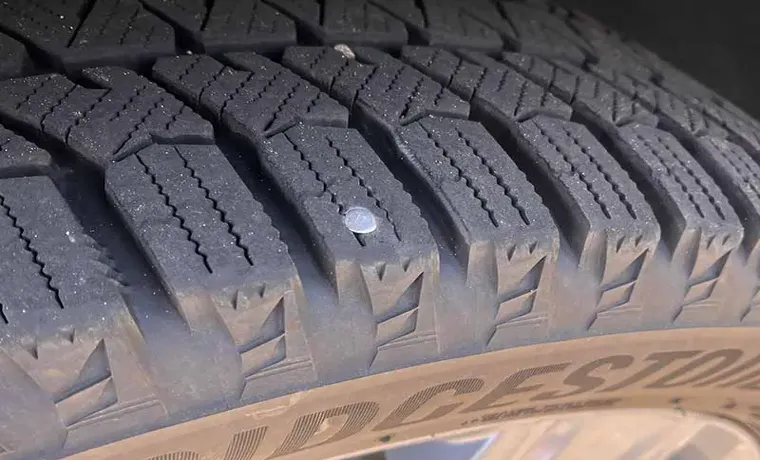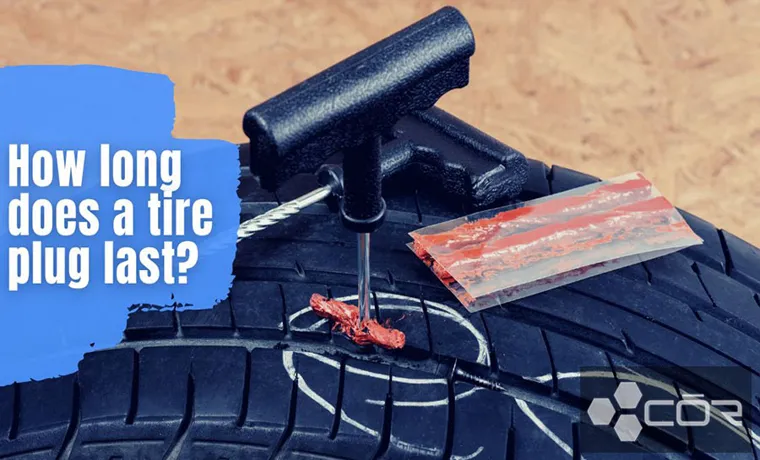Do you know how important it is to make sure your car’s tires are in good condition? Not only is it necessary for a smooth and safe ride, but it also plays a vital role in your car’s overall performance. One of the factors that can affect your tires’ performance is the plugs used to fill punctures. If you’ve ever had a flat tire, you may have noticed a little rubber plug sticking out of the punctured area.
These plugs are used to fill the hole and prevent air from escaping. But how long do these plugs last? In this blog post, we’ll explore the lifespan of a plug in a tire, so you can ensure your tires are always in top-notch condition.
Table of Contents
Understanding Tire Plugs
If you’ve experienced a punctured tire before, you know how frustrating it can be. Luckily, tire plugs offer an easy and cost-effective solution. But how long do these tiny rubber plugs last before needing to be replaced? The answer to this question depends on a variety of factors.
Generally, though, a plug can last anywhere from a few days to several months or even years, depending on the size and location of the puncture and the quality of the plug. It’s important to remember that a plug is a temporary fix and should not be relied on for permanent repairs. It’s always best to have your tire inspected by a professional and consider a permanent repair or replacement if necessary.
In summary, while a tire plug can provide a quick fix for a puncture, it’s best to not depend on it for long-term use and to have your tire checked by an expert.
What is a Tire Plug?
A tire plug is a small, rubber-coated piece of metal or plastic that is used to fix small punctures in a tire. Essentially, it is an emergency repair kit for your tire, designed to provide a temporary solution until you can get to a mechanic or tire shop for a more permanent fix. When you get a flat tire, you can remove the foreign object (like a nail) that caused the puncture and then insert the tire plug into the hole.
This creates a seal that can help prevent air from leaking out of the tire. While tire plugs are a convenient fix, it’s important to remember that they are not a long-term solution. Tire plugs are meant to be used as a temporary fix until a proper tire repair can be performed by a professional.
So, if you’re in a hurry and need to get back on the road quickly, a tire plug can be a useful tool to have in your trunk.

How to Plug a Tire?
If you’ve ever been stuck on the side of the road with a flat tire, then you know how frustrating it can be. However, with the right equipment and a bit of knowledge, you can quickly and easily plug a tire yourself and get back on the road. Tire plugs are an effective way to repair punctured tires and can be done without removing the tire from the vehicle.
In essence, a tire plug fills the hole in the tire caused by a puncture and prevents air from escaping. To plug a tire, you will need a tire plug kit that includes a reaming tool, a plug insertion tool, and tire plugs. Once you have located the puncture, use the reaming tool to clean out the debris from the hole, then insert the plug into the hole using the insertion tool.
Voila! You have successfully plugged your tire and can now continue on with your journey. Remember to inflate your tire to its recommended pressure and to seek out a professional to fully repair or replace the tire as soon as possible.
Factors Affecting Plug Life
How long a plug lasts in a tire depends on various factors. The first factor is the size and location of the puncture. If the hole is small and located on the tread or shoulder of the tire, the plug is likely to last longer.
However, larger punctures on the sidewall or near the shoulder can cause the plug to fail sooner. Another factor is the quality of the plug used and the skill of the person installing it. High-quality plugs made from materials like vulcanized rubber and equipped with a metal core tend to last longer.
However, if the plug is not installed properly or the puncture is not cleaned thoroughly, it could fail prematurely. Finally, factors like weather conditions, road surface, and driving habits can also affect how long a plug lasts. Excessive heat, rough surfaces, and high speeds can cause the plug to wear out faster.
Overall, most plugs can last anywhere from a few weeks to several years depending on these factors.
Type of Plug Used
When it comes to the factors that affect spark plug life, one crucial aspect to consider is the type of plug used. Different types of spark plugs are designed to work with specific engines, which means that choosing the wrong type can drastically reduce their lifespan. For instance, standard copper plugs tend to have shorter lifespans than their platinum or iridium counterparts, which can last up to 100,000 miles or more.
Additionally, the heat range of the spark plug is another key factor to consider. If the plug’s heat range is too low for the engine, it can cause premature fouling and plug wear. On the other hand, if the heat range is too high, it can cause detonation and engine damage.
Therefore, it’s important to consult with a professional mechanic or refer to the owner’s manual to choose the best type of plug for your vehicle to ensure optimal performance and longevity.
Type of Tire
When it comes to determining the lifespan of a tire plug, one of the biggest factors to consider is the type of tire you are working with. For instance, a plug in a soft compound tire will likely have a shorter life span than a plug in a harder compound tire. This is because the softer tire material is more prone to wear and tear, so the plug is more likely to become dislodged or damaged over time.
Additionally, tires that are regularly exposed to harsh weather conditions may also experience a shorter plug life due to the added stress placed on the tire and plug. When choosing a tire plug, it’s important to select one that is compatible with your specific tire type to maximize its longevity and effectiveness. By selecting the right type of tire plug, you can help ensure a safer and longer-lasting driving experience.
Driving Conditions
When it comes to Electric Vehicle (EV) plug life, there are several factors that contribute to its longevity. One of these significant factors is the driving conditions. Extreme temperature changes, such as very hot or cold weather, can take a toll on the EV’s battery system and ultimately affect the plug’s life.
Additionally, frequent high-speed driving can cause overheating of both the battery and the charging system and can lead to faster wear and tear of the plug. Furthermore, the rough terrain and bumpy roads can cause the plug and the connection points to loosen, which can lead to charging issues. So, it’s essential to take care of your EV properly and consider the driving conditions as it affects plug life.
By ensuring the proper maintenance and following the manufacturer’s guidelines, you can improve the longevity of your EV plug and save money in the long run.
Average Lifespan of a Tire Plug
If you’ve ever had to deal with a flat tire, you may have used a tire plug to fix the issue quickly and conveniently. But how long does a plug last in a tire? The answer depends on a few factors, such as the type of plug, driving conditions, and the age of the tire. Generally, a tire plug can last anywhere from a few days to several months, depending on these factors.
For example, a plug placed in a brand new tire may last longer than a plug placed in an older tire with worn-out treads. Similarly, if you frequently drive on rough roads or encounter extreme temperatures, your plug may not last as long as it would in milder conditions. That being said, it’s important to remember that a tire plug is not a permanent fix and should be seen as a temporary solution until you can get your tire repaired or replaced.
Ultimately, how long a plug lasts in a tire depends on many variables, but it’s always best to prioritize safety and get your tire checked by a professional as soon as possible.
Manufacturer Recommendations
When it comes to tire plugs, many people are unaware of the average lifespan they can expect from one. While there is no set answer as to how long a tire plug can last, it’s important to follow the recommendations of the manufacturer. Most manufacturers suggest that a tire plug should only be used as a temporary repair, with a maximum lifespan of six years.
Additionally, if a plug is not installed properly or in the correct location, it could fail much sooner. It’s important to have any tire repairs done by a professional to ensure they are performed correctly and safely. While tire plugs can be a quick and easy fix for a punctured tire, they should only be used as a temporary solution until the tire can be properly repaired or replaced.
So, if you have a tire that needs repair, be sure to follow the manufacturer recommendations and have it taken care of by a professional to ensure your safety on the road.
Real-Life Examples
When it comes to tire plugs, many drivers wonder how long these handy little fixers will actually hold up. While the answer isn’t always straightforward, the average lifespan of a tire plug can vary based on several factors. Generally speaking, a properly installed and high-quality tire plug can last anywhere from a few months to a few years.
However, the lifespan of your tire plug will also depend on how often you drive, the terrain you encounter, and the types of weather you regularly face. For example, if you frequently drive on rough roads or in extreme temperatures, your tire plug may wear out faster than someone who drives on smoother roads and in milder weather conditions. It’s also important to note that tire plugs are only intended to provide a temporary fix, so it’s always a good idea to get your tire professionally replaced as soon as possible after a puncture.
Overall, while a tire plug can be a quick and convenient solution in a pinch, it’s important to keep in mind that it’s not a permanent fix and will eventually need to be replaced.
When to Replace a Tire Plug?
When it comes to tire plugs, the question of how long they last is a common one. While there’s no definitive answer to this, there are some factors that can give you a general idea of when it’s time to replace a plug. The type of plug and the type of tire can both impact how long a plug will last.
Generally speaking, a plug on a small puncture in a tire can last a long time, maybe even for the life of the tire, but it’s always best to have them checked by a professional. However, if the puncture is larger or the plug is not installed properly, the plug may only last for a short time. Additionally, the age of the tire can also impact the life of a plug.
If a tire is already nearing the end of its useful life, then it may be safer to replace the tire altogether, rather than relying on a plug to keep it in good condition. In general, it’s always best to err on the side of caution when it comes to tire plugs and consult a professional if you have any concerns.
Conclusion
In conclusion, the lifespan of a plug in a tire is as unpredictable as the weather in March. It could last for weeks, months, or even years, but just like your ex’s promises, it’s not guaranteed to hold up in the long run. So, while a plug might seem like a quick fix for a flat tire, it’s always better to invest in a proper patch and keep your vehicle road-worthy for miles to come.
Remember, safety always trumps convenience, so don’t let a small patch lead to a big disaster down the road!”
FAQs
What is a plug in a tire, and how does it work?
A plug is a temporary repair for a punctured tire that involves inserting a rubber plug into the puncture hole. The plug is held in place by the air pressure in the tire and can prevent air from leaking out.
How long can a plug last in a tire?
The lifespan of a plug in a tire can vary depending on various factors like the size and location of the puncture, the quality of the plug, driving conditions, and how quickly the puncture is repaired. However, a tire plug is generally considered a temporary repair and should be replaced with a permanent solution as soon as possible.
Is it safe to drive on a tire with a plug?
Driving on a tire with a plug is considered safe only for a short distance at a low speed. The plug is a temporary solution and only meant to get the vehicle to a repair shop. Driving on a tire with a plug for an extended period could be dangerous and may cause further damage to the tire.
How much does it cost to replace a tire plug?
The cost of replacing a tire plug can vary depending on the location and extent of the damage. The replacement cost could range from a few dollars for a simple puncture to several hundred dollars for a more severe injury that requires a tire replacement.
Can I plug a sidewall puncture in a tire?
No, it is not safe to plug a sidewall puncture in a tire as this can compromise the structural integrity of the tire and pose a risk of blowout. Sidewall punctures require a tire replacement.
How can I prevent tire punctures?
Regular tire maintenance, such as checking tire pressure and inspecting for worn-out treads, can help prevent tire punctures. Avoiding driving over sharp objects, maintaining a safe distance from other vehicles, and driving carefully on rough roads can also reduce the risk of tire punctures.
What is the difference between a tire patch and a plug?
A tire patch is a permanent repair that involves removing the damaged area and replacing it with a new rubber patch. A tire plug, on the other hand, is a temporary repair that inserts a rubber plug into the punctured hole. A tire patch is considered a more reliable and long-lasting solution than a plug.



